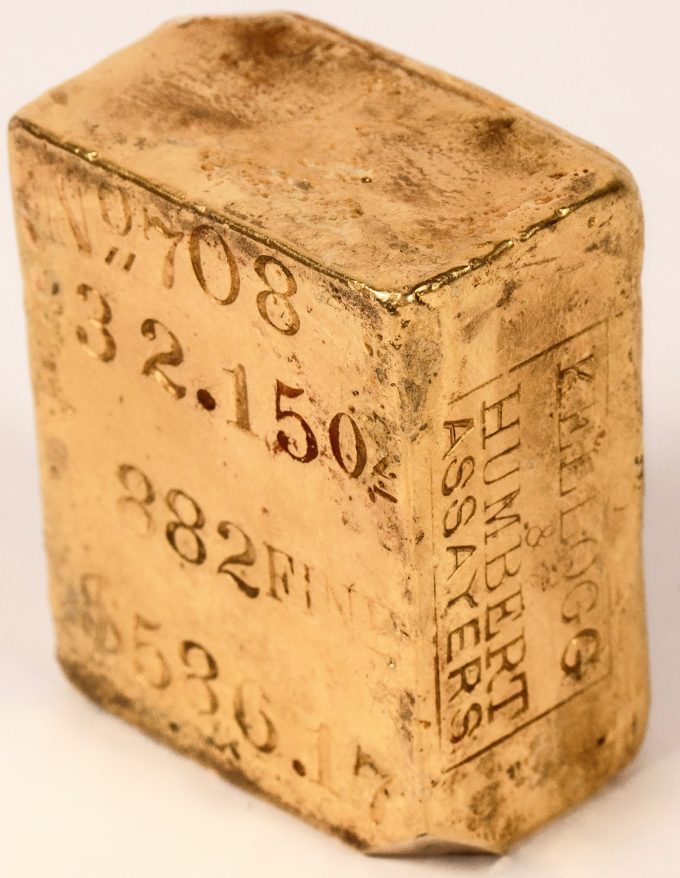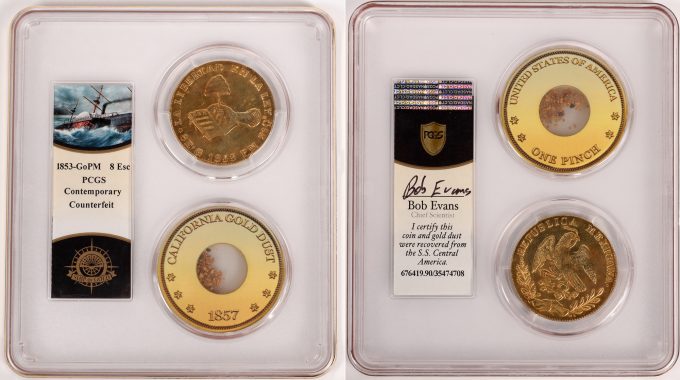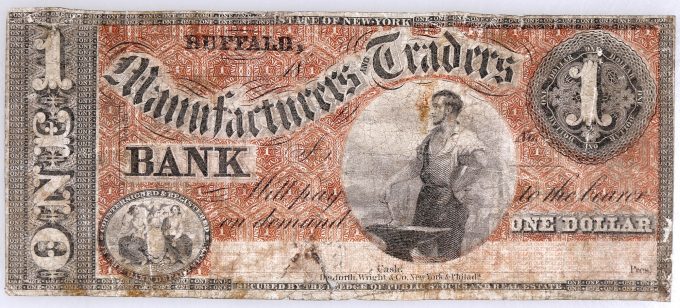A nearly two-pound Kellogg & Humbert assayer’s gold ingot was among the highlights in the second and final auction of never-before-offered California Gold Rush artifacts recovered from the 1857 sinking of the fabled "Ship of Gold," the S.S. Central America.

From lumps of coal and crewmembers’ keys to tableware and exquisite jewelry, collectors bid $1.1 million to acquire the 422 lots in the auction conducted by Holabird Western Americana Collections, LLC (www.HolabirdAmericana.com) in Reno, Nevada on March 4 and 5, 2023.
"We had about 7,000 online bidders, including some from Canada, Europe, and South America. Many collectors were waiting for these extraordinary items to come on the market since the legendary, submerged ship was located in 1988 and Life magazine proclaimed it America’s greatest treasure ever found," said Fred Holabird, President of Holabird Western Americana Collections. "This was an incredible time capsule of the California Gold Rush era."
One of the auction highlights was a 32.15-ounce gold bar created in San Francisco by prominent Gold Rush assayers John Glover Kellogg and Augustus Humbert. The ingot sold for $138,000. The assayer’s hand-stamped value at the time it was created was $586.17.
"Augustus Humbert and John Glover Kellogg are among the most famous assayers in California Gold Rush history. Kellogg & Humbert opened for business in early 1855 and were among the most active and prolific issuers of gold ingots and coins during the mid-1850s," said Dwight Manley, managing partner of California Gold Marketing Group, the consignor of the sunken treasure.
The auction also offered a contemporary counterfeit Mexican 8 Escudos "gold" coin dated 1853 that may have been made in California. It sold for $37,200.
"There were five Mexican gold coins mixed in with dozens of U.S. and world coins in a canvas bag in the ship’s purser’s safe when we recovered it in 2014. Two were genuine gold and copper alloy Mexican coins and three were counterfeits like this one in the auction, composed of a gold and silver alloy," explained Bob Evans, Chief Scientist of the S.S. Central America Project who was on each of the recovery missions.
The coin has been encapsulated by Professional Coin Grading Service in a special holder with a compartment containing a "pinch" of recovered gold dust. The encapsulation label reads: 1853-GoPM 8 Esc / PCGS / Contemporary / Counterfeit.

There was also the only known, complete treasure box from the 1850s California Gold Rush period that sold for $6,300. An embossed wax seal on the box is still easily readable as "Alsop & Co.," renowned merchants and gold treasure shippers of the era.
Six banknotes discovered in the purser’s safe were offered.
A $5 note from North River Bank of New York sold for $3,240; a $20 note from the North River Bank of New York brought $4,440; a $1 note issued by Manufacturers and Traders Bank of Buffalo, New York (Haxby G2a) sold for $5,760; a $5 note from Lee Bank in Lee, Massachusetts brought $3,120; a $10 Bank of Hallowell, Maine (Haxby G10) sold for $2,640; and $2 Wrentham, Massachusetts Bank (Haxby G22) brought $2,040.

Other highlights included:
- A winning bid of $73,200 for a superb resolution, 19th-century daguerreotype metal plate photograph of a young woman. The scientific mission recovery team nicknamed the unidentified woman, "Mona Lisa of the Deep," after retrieving the photo in 2014 from the seabed where it was discovered in a scattered pile of the ship’s coal.
- The specially-built, six-ton remotely operated underwater vehicle nicknamed "Nemo" that was used by scientists and engineers to locate and recover the S.S. Central America treasures deep on the Atlantic Ocean seabed four decades ago sold for $43,200.
- A porthole from what is believed to be Captain William Lewis Herndon’s topside cabin went for $22,200.
- Gold wire-rim eyeglasses retrieved from the wreck site a mile-and-a-half below the Atlantic Ocean surface sold for $13,800.
- A set of gold cufflinks brought $12,000.
- The winning bidder paid $2,760 for the remains of a recovered 1851 Colt Navy pistol.
- A small sign from the ship with the word SALOON went for $13,200.
- The Steward’s key to the ship’s wine storage room sold for $9,300.
- Lumps of recovered ship’s coal sold for hundreds to thousands of dollars each depending on size.
- Six applied-top beer bottles, some still with original beer contents, sold for an average of $1,087 each.
- Thirty-six Cuban cigars apparently brought on board when the ship stopped in Havana on the voyage to New York were offered in 18 separate lots of two cigars per lot and sold for as much as $720 per pair.
- A five-foot-long scale model of the S.S. Central America created in 1991 sold for $50,400.
This was the second and final auction of never-before-offered artifacts from the S.S. Central America. The first auction of 270 other items this past December attracted nearly $1 million in winning bids, including $114,000 for the oldest known pair of miner’s heavy-duty work pants that may have been made by or for the Levi Strauss Company.
"The S.S. Central America was carrying tons of Gold Rush treasure from San Francisco and the northern California area when she sank 7,200 feet deep in the Atlantic off the North Carolina coast in a hurricane while on a voyage from Panama to New York City in September 1857. Recovery from the shipwreck site occurred in several stages between 1988-1991 and again in 2014," explained Evans.
For additional information about the auction, visit Holabird Western Americana Collections of Reno, Nevada at www.HolabirdAmericana.com, call 775-851-1859, or email info@holabirdamericana.com.






You’re right! Everyday there seems to be a new revelation. Must have been a huge haul.
It’s the wreck that keeps on giving.
You can thank Dwight Manley for selling these “dregs” of the nasty “goo goo muck” ocean bottom for many many years now to get rid of it to those who like cleaned coins, ingots etc. His gold marketing company truly made this seawater trash into treasure for his company by selling to those who don’t understand the oxidation damage done to the surface molecules of the coins & ingots that all contain copper that reacts to such environment. But the grading labels don’t say “environmental damage” & only a few even say “shipwreck effect” to let buyers know these things… Read more »
So PCGS is now authenticating & slabbing “contemporary counterfeit” coins!!?? The photo in this article of the counterfeit Mexican gold coin in a PCGS holder is shocking! Once again, the “big boy” coin dealers get special attention to their coins & special labels & even special provenance for their counterfeit coins. Unbelievable!
NumisdudeTX
crickets
Lol. Or freeze-dried infant poop graded by consistency, color, smell & size!
NumisdudeTX